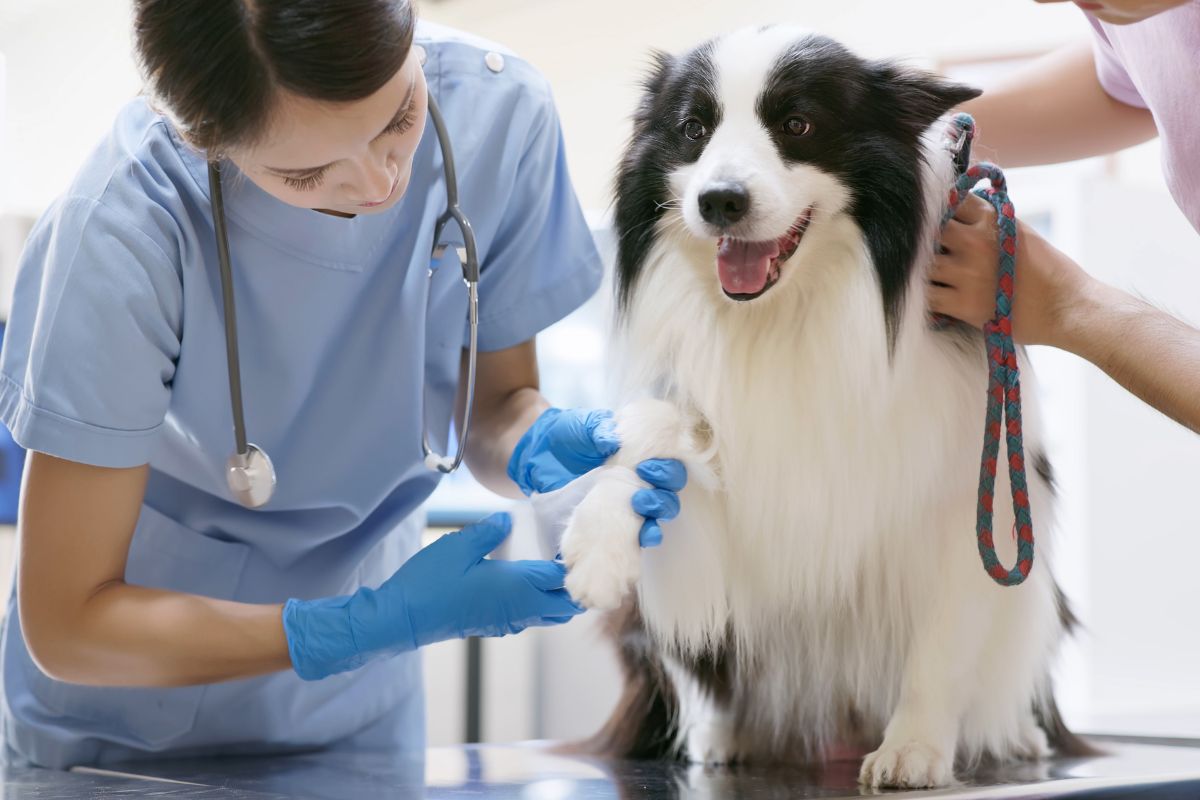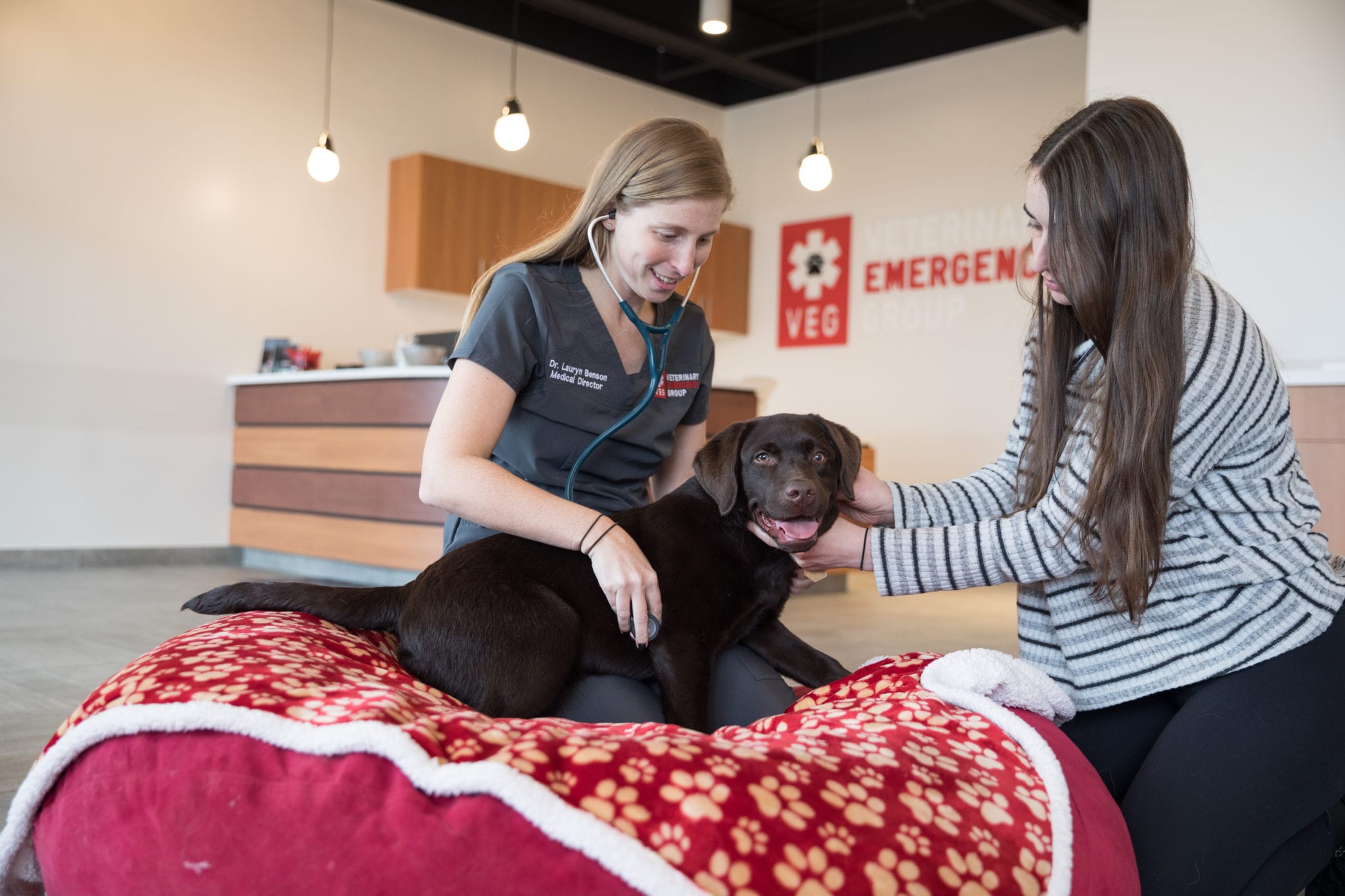Home>Health & Wellness>Common Health Issues>Muscular and Joint Health>How To Treat A Dog With Back Arthritis


Muscular and Joint Health
How To Treat A Dog With Back Arthritis
Modified: March 1, 2024
Learn how to improve your dog's muscular and joint health with effective treatments for back arthritis. Find expert tips and advice to help your furry friend feel better.
(Many of the links in this article redirect to a specific reviewed product. Your purchase of these products through affiliate links helps to generate commission for Pawsomeoldies.com, at no extra cost. Learn more)
Table of Contents
Introduction
Back arthritis, also known as spondylosis deformans, is a common condition that affects dogs, particularly as they age. This degenerative condition can cause discomfort, reduced mobility, and a decreased quality of life for our beloved canine companions. As responsible pet owners, it's crucial to understand the signs, symptoms, and treatment options available to help manage and alleviate the discomfort associated with back arthritis in dogs.
Arthritis is a progressive condition that affects the joints, leading to inflammation, pain, and stiffness. When it occurs in the spine, it can significantly impact a dog's ability to move comfortably and perform daily activities. As a result, pet owners must be vigilant in recognizing the early signs of back arthritis and seek appropriate care to ensure their furry friends can lead happy and pain-free lives.
In this comprehensive guide, we will delve into the various aspects of back arthritis in dogs, including its causes, symptoms, diagnosis, and treatment options. Additionally, we will explore strategies for managing your dog's pain, incorporating exercise and physical therapy, optimizing nutrition and supplements, and making environmental modifications to improve your dog's comfort and mobility.
By gaining a deeper understanding of back arthritis and the available interventions, you can empower yourself to provide the best possible care for your canine companion. Together, we can navigate the challenges of back arthritis in dogs and work towards enhancing their overall well-being and quality of life.
Read more: How To Treat Cancer In Dogs
Understanding Back Arthritis in Dogs
Back arthritis, or spondylosis deformans, is a degenerative condition that affects the spine of dogs. It is characterized by the formation of bony spurs or bridges between the vertebrae, leading to stiffness, discomfort, and reduced mobility. While back arthritis is commonly associated with aging, it can also result from wear and tear, genetic predisposition, or previous spinal injuries.
The development of back arthritis in dogs is often a gradual process, with the initial stages showing minimal to no symptoms. As the condition progresses, affected dogs may experience stiffness, reluctance to engage in physical activities, and changes in posture or gait. The discomfort associated with back arthritis can lead to reduced flexibility and a reluctance to jump, run, or climb stairs.
It's important to note that back arthritis can affect dogs of all breeds and sizes, although larger breeds and those with a genetic predisposition may be more susceptible. Additionally, overweight or obese dogs are at a higher risk of developing back arthritis due to the increased strain on their spine and joints.
Understanding the underlying causes and progression of back arthritis in dogs is crucial for early detection and intervention. By recognizing the subtle signs of discomfort and changes in mobility, pet owners can take proactive measures to seek veterinary care and explore appropriate treatment options.
As we delve deeper into the management of back arthritis in dogs, it's essential to consider the impact of this condition on our canine companions' overall well-being. By gaining insight into the intricacies of back arthritis, we can equip ourselves with the knowledge and empathy needed to provide compassionate and effective care for our furry friends.
Signs and Symptoms
Recognizing the signs and symptoms of back arthritis in dogs is crucial for early intervention and effective management of the condition. While dogs may not verbally communicate their discomfort, observant pet owners can identify subtle changes in behavior and movement that indicate the presence of back arthritis.
-
Stiffness and Reduced Mobility: Dogs with back arthritis may exhibit stiffness, particularly after periods of rest or inactivity. They may struggle to rise from a lying position and show reluctance to engage in physical activities such as running, jumping, or climbing stairs.
-
Altered Gait and Posture: A noticeable change in a dog's gait or posture can be indicative of back arthritis. Dogs may adopt a hunched or rigid stance, and their movements may appear hesitant or unsteady.
-
Decreased Activity Levels: Dogs experiencing discomfort due to back arthritis may demonstrate a decrease in overall activity levels. They may be less inclined to participate in playtime or exercise and may exhibit signs of lethargy or reluctance to move.
-
Pain Responses: Dogs may exhibit signs of pain when their back or spine is touched or manipulated. They may vocalize, flinch, or exhibit signs of discomfort when pressure is applied to the affected area.
-
Behavioral Changes: Changes in behavior, such as irritability, restlessness, or seeking isolation, can be indicative of underlying discomfort associated with back arthritis.
-
Reduced Appetite: Some dogs may experience a decreased appetite as a result of the discomfort and pain associated with back arthritis. This change in eating habits can be a subtle yet significant indicator of underlying health issues.
-
Urinary or Fecal Incontinence: In advanced cases of back arthritis, dogs may experience difficulties controlling their bladder or bowel movements due to the impact of the condition on their spinal nerves.
By remaining attentive to these signs and symptoms, pet owners can promptly seek veterinary evaluation and explore appropriate treatment options to alleviate their dog's discomfort and improve their quality of life. Early detection and intervention play a pivotal role in managing back arthritis in dogs and mitigating its impact on their overall well-being.
Diagnosis and Treatment Options
Diagnosing back arthritis in dogs typically involves a comprehensive evaluation by a veterinarian, including a physical examination, imaging studies, and a review of the dog's medical history. During the physical examination, the veterinarian may observe the dog's gait, posture, and range of motion, while also palpating the spine to identify areas of tenderness or discomfort. Additionally, imaging studies such as X-rays or advanced imaging modalities like MRI or CT scans may be utilized to visualize the extent of spinal changes and assess the severity of the condition.
Once a diagnosis of back arthritis is confirmed, the veterinarian will collaborate with the pet owner to develop a tailored treatment plan based on the dog's specific needs and the stage of the condition. Treatment options for back arthritis in dogs aim to alleviate pain, improve mobility, and slow the progression of the degenerative changes in the spine. These options may include:
-
Medications: Non-steroidal anti-inflammatory drugs (NSAIDs) are commonly prescribed to manage pain and reduce inflammation associated with back arthritis. Additionally, pain medications and muscle relaxants may be recommended to provide symptomatic relief and improve the dog's comfort.
-
Physical Therapy: Physical therapy and rehabilitation techniques, including therapeutic exercises, massage, and hydrotherapy, can help improve the dog's strength, flexibility, and overall mobility. These interventions are designed to support the dog's musculoskeletal health and enhance their quality of life.
-
Acupuncture and Chiropractic Care: Alternative therapies such as acupuncture and chiropractic adjustments may be incorporated into the treatment plan to alleviate pain, promote relaxation, and restore balance in the dog's musculoskeletal system.
-
Weight Management: For overweight or obese dogs, weight management strategies are essential to reduce the strain on the spine and joints. A tailored nutrition plan and regular exercise regimen can help manage the dog's weight and alleviate the impact of excess body mass on their musculoskeletal health.
-
Surgical Interventions: In severe cases of back arthritis, surgical options such as spinal decompression or stabilization may be considered to address structural abnormalities and alleviate pressure on the spinal cord and nerves.
-
Lifestyle Modifications: Environmental adaptations, such as providing supportive bedding, ramps or steps for easier access to elevated surfaces, and minimizing activities that exacerbate spinal discomfort, can significantly enhance the dog's comfort and mobility at home.
By combining these treatment modalities and customizing the approach to suit the individual needs of the dog, pet owners can play a proactive role in managing back arthritis and optimizing their canine companion's overall well-being. Regular follow-up appointments with the veterinarian allow for ongoing assessment of the dog's response to treatment and the adjustment of the management plan as needed.
In summary, the diagnosis and treatment of back arthritis in dogs require a multifaceted approach that integrates medical interventions, lifestyle modifications, and supportive care to address the unique challenges posed by this degenerative condition. Through collaborative efforts between pet owners and veterinary professionals, dogs with back arthritis can receive comprehensive care that focuses on minimizing discomfort, enhancing mobility, and promoting their long-term musculoskeletal health.
Managing Your Dog's Pain
Managing your dog's pain is a crucial aspect of addressing back arthritis and enhancing their overall quality of life. As responsible pet owners, it's essential to prioritize your dog's comfort and well-being by implementing strategies to alleviate their discomfort and minimize the impact of back arthritis on their daily activities.
Medication Management
One of the primary approaches to managing your dog's pain involves the use of prescribed medications, such as non-steroidal anti-inflammatory drugs (NSAIDs) and pain relievers. These medications are aimed at reducing inflammation, alleviating discomfort, and improving your dog's mobility. It's imperative to administer these medications as directed by your veterinarian, ensuring the appropriate dosage and monitoring for any potential side effects.
Environmental Comfort
Creating a comfortable and supportive environment for your dog is essential in managing their pain. Providing a well-padded and orthopedic bed can help alleviate pressure on their spine and joints, promoting restful sleep and minimizing discomfort. Additionally, offering easy access to food, water, and outdoor areas can reduce the need for strenuous movements, contributing to your dog's overall comfort.
Temperature Regulation
Maintaining a comfortable temperature within your home can have a positive impact on your dog's pain management. Extreme cold or heat can exacerbate joint stiffness and discomfort, so ensuring a warm and cozy environment during colder months and providing access to shaded areas during warmer weather can help alleviate your dog's pain.
Gentle Massage and Physical Support
Gentle massage techniques can provide relief for your dog by promoting relaxation, improving circulation, and reducing muscle tension. Additionally, providing physical support, such as assisting your dog with standing up or navigating stairs, can minimize the strain on their affected joints and enhance their mobility.
Emotional Support and Monitoring
Emotional support plays a significant role in managing your dog's pain. Offering reassurance, comfort, and companionship can help alleviate their stress and contribute to their overall well-being. Furthermore, closely monitoring your dog's behavior, appetite, and response to pain management strategies allows for timely adjustments and ensures that their comfort remains a top priority.
By implementing these pain management strategies and maintaining open communication with your veterinarian, you can actively contribute to your dog's well-being and comfort. It's essential to approach pain management holistically, considering both medical interventions and supportive care to address the multifaceted nature of back arthritis in dogs. Through your dedication and proactive approach, you can make a meaningful difference in managing your dog's pain and enhancing their quality of life.
Exercise and Physical Therapy
Exercise and physical therapy play pivotal roles in the management of back arthritis in dogs, offering multifaceted benefits that encompass improved mobility, enhanced muscle strength, and overall musculoskeletal health. When tailored to the specific needs and limitations of dogs with back arthritis, these interventions can significantly contribute to their comfort, well-being, and long-term quality of life.
Tailored Exercise Regimen
Designing a tailored exercise regimen for dogs with back arthritis involves striking a balance between promoting physical activity and minimizing strain on the affected joints and spine. Low-impact activities, such as leash walking, swimming, and gentle stretching exercises, can help maintain muscle tone, improve flexibility, and support overall joint health without exacerbating discomfort. It's essential to avoid activities that involve high-impact movements, abrupt changes in direction, or prolonged periods of strenuous exercise, as these can place undue stress on the dog's spine and joints.
Physical Therapy Techniques
Physical therapy techniques, including therapeutic exercises and massage, are integral components of the comprehensive management of back arthritis in dogs. Therapeutic exercises are designed to target specific muscle groups, improve range of motion, and enhance overall strength and flexibility. These exercises are often performed under the guidance of a veterinary rehabilitation specialist and are tailored to the individual needs and capabilities of the dog. Additionally, massage therapy can help alleviate muscle tension, improve circulation, and promote relaxation, contributing to the dog's overall comfort and mobility.
Hydrotherapy
Hydrotherapy, which involves exercises performed in a controlled aquatic environment, offers unique benefits for dogs with back arthritis. The buoyancy of water reduces the impact on the dog's joints while providing resistance for muscle strengthening. Under the supervision of a qualified professional, hydrotherapy sessions can enhance the dog's mobility, improve muscle tone, and alleviate discomfort associated with back arthritis. Additionally, the soothing properties of water can promote relaxation and reduce stress, contributing to the dog's overall well-being.
Monitoring and Adaptation
Regular monitoring of the dog's response to exercise and physical therapy is essential for assessing their progress and making necessary adaptations to the regimen. Observing the dog's gait, posture, and overall comfort during and after exercise sessions allows for adjustments to be made based on their individual needs and limitations. Open communication with the veterinary rehabilitation specialist ensures that the exercise and physical therapy regimen remains tailored to the dog's evolving condition, optimizing its effectiveness in managing back arthritis.
By incorporating tailored exercise regimens, physical therapy techniques, and hydrotherapy into the comprehensive care plan for dogs with back arthritis, pet owners can actively contribute to their canine companions' musculoskeletal health and overall well-being. These interventions, when thoughtfully implemented and monitored, can enhance the dog's comfort, mobility, and quality of life, fostering a fulfilling and active lifestyle despite the challenges posed by back arthritis.
Nutrition and Supplements
Nutrition plays a fundamental role in supporting the overall health and well-being of dogs, particularly those affected by back arthritis. A balanced and tailored diet can contribute to weight management, joint health, and the reduction of inflammation, thereby positively impacting the management of back arthritis. When considering the nutritional needs of dogs with back arthritis, several key factors should be taken into account to optimize their dietary intake and support their musculoskeletal health.
Balanced Diet
A balanced diet tailored to the specific needs of dogs with back arthritis is essential for maintaining a healthy weight and supporting joint function. High-quality commercial dog foods formulated for joint health often contain essential nutrients such as omega-3 fatty acids, glucosamine, and chondroitin, which have been shown to support joint health and reduce inflammation. Additionally, incorporating lean protein sources, healthy fats, and a variety of fruits and vegetables can provide essential nutrients and antioxidants that contribute to overall well-being.
Read more: How To Treat A Dog With Fleas
Weight Management
For dogs with back arthritis, maintaining an optimal body weight is crucial for reducing the strain on their joints and spine. Excess body weight can exacerbate discomfort and limit mobility, further impacting the progression of the condition. By working with a veterinarian to determine the ideal weight for the dog and implementing a tailored nutrition plan, pet owners can actively contribute to the management of back arthritis and support their dog's overall musculoskeletal health.
Joint Supplements
Supplements designed to support joint health, such as glucosamine, chondroitin, and omega-3 fatty acids, can play a valuable role in managing back arthritis in dogs. These supplements are known for their potential to reduce inflammation, support cartilage health, and improve joint mobility. When considering the incorporation of joint supplements into the dog's diet, it's essential to consult with a veterinarian to ensure the appropriate dosage and suitability for the individual dog's needs.
Antioxidants and Anti-Inflammatory Nutrients
Incorporating antioxidants and anti-inflammatory nutrients into the dog's diet can contribute to the management of back arthritis by reducing oxidative stress and inflammation. Nutrients such as vitamin E, vitamin C, and beta-carotene, found in fruits and vegetables, can support the dog's overall health and potentially alleviate the impact of inflammatory processes associated with back arthritis.
Hydration
Proper hydration is essential for dogs with back arthritis, as it supports joint lubrication and overall cellular function. Providing access to clean and fresh water at all times is crucial for maintaining the dog's hydration levels and supporting their musculoskeletal health.
By prioritizing a balanced and tailored nutrition plan, incorporating joint supplements when appropriate, and ensuring proper hydration, pet owners can actively contribute to the management of back arthritis in dogs. A proactive approach to nutrition and supplements, in collaboration with veterinary guidance, can significantly impact the dog's comfort, mobility, and overall quality of life.
Read more: How Much Is Cortisone For Dog Arthritis
Environmental Modifications
Environmental modifications play a crucial role in enhancing the comfort and mobility of dogs affected by back arthritis. By creating a supportive and accommodating living space, pet owners can significantly alleviate the challenges posed by the condition and improve their canine companions' overall well-being.
One of the key considerations in environmental modifications is providing supportive bedding for the dog. Orthopedic beds with ample cushioning and support can help alleviate pressure on the dog's spine and joints, promoting restful sleep and minimizing discomfort. Additionally, ensuring that the bedding is easily accessible and located in a quiet, low-traffic area can contribute to the dog's overall comfort.
Ramps or steps can be invaluable additions to the home environment, particularly for dogs with back arthritis. These assistive devices provide easier access to elevated surfaces such as sofas, beds, or vehicles, minimizing the need for strenuous jumping or climbing. By reducing the impact of vertical movement on the dog's spine and joints, ramps and steps can enhance their mobility and independence.
Minimizing activities that exacerbate spinal discomfort is another essential aspect of environmental modifications. This may involve restricting access to areas with challenging terrain, such as steep stairs or uneven surfaces, to prevent unnecessary strain on the dog's musculoskeletal system. Creating a safe and controlled environment that minimizes the risk of falls or injuries is paramount in supporting the dog's mobility and comfort.
Incorporating non-slip flooring throughout the living space can significantly enhance the dog's stability and confidence in movement. Area rugs or mats with a non-skid backing can provide traction and support, particularly on smooth surfaces such as hardwood or tile floors. By reducing the risk of slips and falls, non-slip flooring contributes to the dog's overall safety and comfort.
Furthermore, maintaining a comfortable temperature within the home environment is essential for dogs with back arthritis. Extreme cold or heat can exacerbate joint stiffness and discomfort, so ensuring a warm and cozy environment during colder months and providing access to shaded areas during warmer weather can help alleviate the dog's pain and promote their overall well-being.
By implementing these environmental modifications, pet owners can create a supportive and accommodating living space that minimizes the impact of back arthritis on their canine companions. These thoughtful adaptations contribute to the dog's comfort, mobility, and overall quality of life, fostering a nurturing and inclusive environment that addresses the unique challenges posed by back arthritis.
Conclusion
In conclusion, the management of back arthritis in dogs requires a multifaceted approach that encompasses early recognition of signs and symptoms, proactive veterinary care, and a comprehensive care plan tailored to the individual needs of each canine companion. By gaining a deeper understanding of the underlying causes and progression of back arthritis, pet owners can play an active role in promoting the well-being and comfort of their furry friends.
Recognizing the subtle signs of stiffness, altered gait, and reduced activity levels is pivotal in initiating timely veterinary evaluation and diagnosis. Through collaborative efforts with veterinary professionals, pet owners can explore a range of treatment options, including medication management, physical therapy, and lifestyle modifications, to alleviate pain, improve mobility, and slow the progression of the condition.
Furthermore, prioritizing nutrition and supplements tailored to support joint health, weight management, and overall well-being can significantly impact the dog's comfort and musculoskeletal health. Environmental modifications, such as providing supportive bedding, ramps or steps, and non-slip flooring, create a nurturing and accommodating living space that minimizes the impact of back arthritis on the dog's daily activities.
By incorporating tailored exercise regimens, physical therapy techniques, and hydrotherapy, pet owners can actively contribute to their canine companions' musculoskeletal health and overall well-being. These interventions, when thoughtfully implemented and monitored, can enhance the dog's comfort, mobility, and quality of life, fostering a fulfilling and active lifestyle despite the challenges posed by back arthritis.
In essence, the management of back arthritis in dogs requires a holistic and compassionate approach that integrates medical interventions, supportive care, and ongoing monitoring to address the multifaceted nature of the condition. By prioritizing the comfort, well-being, and quality of life of their canine companions, pet owners can navigate the challenges of back arthritis with empathy, resilience, and a commitment to providing the best possible care for their furry friends.










